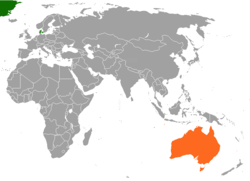Australian-Danish relations

|
|
|
|
|
| Australia | Denmark |
Bilateral relations between the State of Australia and the Kingdom of Denmark , including the Faroe Islands and Greenland , have existed since diplomatic relations were established in 1948 and 1979, respectively.
Political Relations
Australia operates an embassy in the Danish capital, Copenhagen , which resumed operations in 2002 after being temporarily closed in 1997. The Danish Embassy in Canberra closed in 2002 and reopened in 2007.
A “Working Holyday Maker” and a social security agreement were signed in 2001. In 1981 Australia and Denmark signed a double taxation treaty .
Economic relationships
Australian exports to Denmark, mainly alcoholic beverages, beef and nuts, were A $ 120 million in 2015 . Danish exports to Australia, mainly meat (excluding beef), medicines and toys, amounted to A $ 1.125 billion in 2015.
Australia is Denmark's 17th largest export and 49th largest source of imports. Denmark is Australia's 55th largest export and 29th largest import source.
Cultural and historical relationships
One of the earliest Australian census statistics from 1871 shows 1,014 Danes in Victoria , 554 in New South Wales and 15 in Tasmania . It can be assumed that many of these Danes came to Australia because of the gold rush at the time. When gold mining was no longer profitable in the 1870s, many Danes moved to the countryside and cities. Between 1870 and 1900, the first Danish and Scandinavian organizations came into being in Australia. From the 1880s onwards, numerous experts from Denmark became involved in the developing industry and agriculture of Australia. People of Danish origin were also subsequently involved in Australian culture, politics and also in the judiciary. An example is Sir Johannes Bjelke-Petersen (1911-2005), an Australian politician with the Conservative Country Party and longtime Prime Minister of Queensland . After the end of the Second World War , numerous Danes emigrated to Australia. In 1991, a census in Australia recorded 9,368 people who said they were born in Denmark. This was the historical high so far. Today there are a few local organizations in Australia dedicated to Danish culture, history and language.
The Sydney Opera House , designed by Danish architect Jørn Utzon , turned 40 in 2013. It is the UNESCO - World Heritage Site was declared and a very well-known example of an Australian-Danish cooperation. There are a number of Danish landmarks in Australia, including Arnhem Land , Cape Leeuwin and Denmark , which is named after the Denmark River .
population
During the 2011 Australian census, 54,000 Australians said they were of Danish origin. Around 700 Danes study in Australia each year.
Individual evidence
- ^ A b Denmark Country Brief , page of the Australian Ministry of Foreign Affairs with information on Australian-Danish relations, last accessed on October 23, 2016
- ↑ Denmark .PDF, page of the Australian Ministry of Foreign Affairs, last accessed on October 23, 2016
- ↑ James Jupp: The Australian People. An Encyclopedia of the Nations. Its People and Orgins. Pp. 253 ff. Cambridge University Press 2001. ISBN 0-521-80789-1 . Download on Googlebooks
